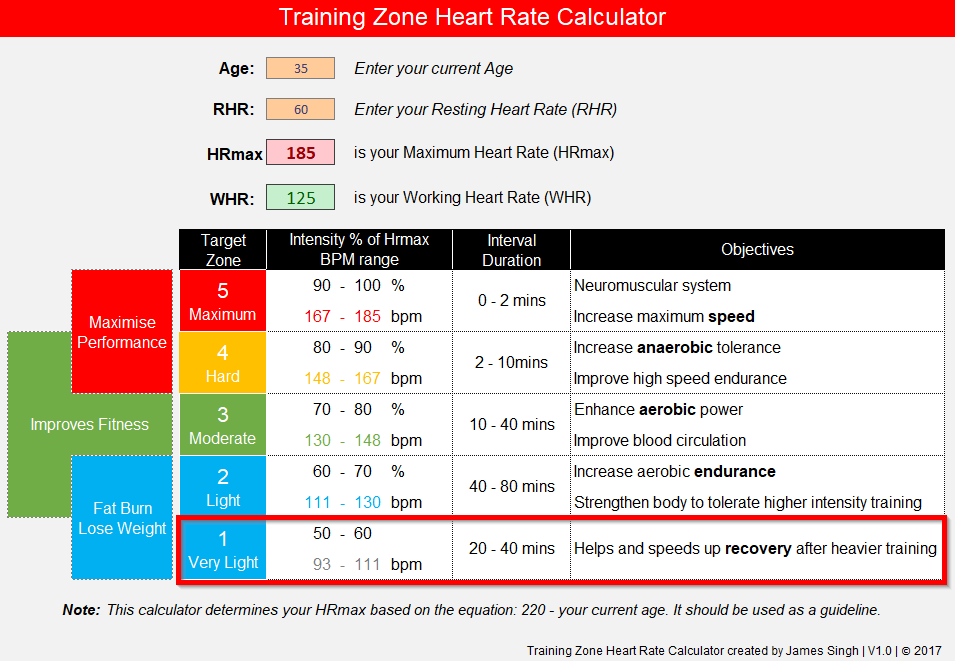To improve your fitness levels you’ll need to make sure you are training in the right heart rate Target Zone. Your maximun heart rate is calculated by your age. Your training heart rate is determined by your level of fitness and your age.
Beginners should start at a training heart rate zone of 50-70% of your maximum heart rate. Whereas, for fitter individuals a training heart rate zone of 70-85% of your maximum may be more appropriate.

Example of zone training levels for a 35 year old
Download Zone Training Calculator
Download content is a Windows Excel spreadsheet document (file size 14KB)
5 Heart Rate Training Zones
There are 5 heart rate training zones that will help guide your training and achieve the fitness levels you are striving for.
1. Very Light
This is the safest, most comfortable zone, reached by walking briskly. Here you strengthen your heart and improve muscle mass while you reduce body fat, cholesterol, blood pressure, and your risk for degenerative disease. You get healthier in this zone, but not more fit, that is, it won't increase your endurance or strength but it will increase your health.
If you're out of shape, have heart problems, or simply want to safeguard your heart without working too hard, spend most of your training time here. It's also the zone for warming up and cooling down before and after more vigorous zones.
2.Light
It's easily reached by jogging slowly. While still a relatively low level of effort, this zone starts training your body to increase the rate of fat release from the cells to the muscles for fuel.
Some people call this the "fat burning zone" because up to 85 % of the total calories burned in this zone are fat calories which is equally as important.
Fit and unfit people burn fat differently. The more fit you are, the more effectively you use fat to maintain a healthy weight. On the other hand, perhaps you've been exercising vigorously, but not losing the weight you expected to. Could be you've been working too hard and need to drop back to this zone and exercise longer. To burn more total calories you'll need to exercise for more time in this zone.
3. Moderate
Moderate zone level training is reached by running easily as an example you improve your functional capacity. The number and size of your blood vessels actually increase, you step up your lung capacity and respiratory rate, and your heart increases in size and strength so you can exercise longer before becoming fatigued. You're still metabolising fats and carbohydrates at about a 50-50 rate which means both are burning at the same ratio.
4. Hard
This zone is reached by going hard - running faster. Here you get faster and fitter, increasing your heart rate as you cross from aerobic to anaerobic training. At this point, your heart cannot pump enough blood and oxygen to supply the exercising muscles fully so they respond by continuing to contract anaerobically.
This is where you "feel the burn." You can stay in this zone for a limited amount of time. That's because the muscle just cannot sustain working anaerobically (this means without sufficient oxygen) without fatiguing. The working muscles protect themselves from overwork by not being able to maintain the intensity level.
5. Maximum
This is the equivalent of running all out and is used mostly as an "interval" training regiment. Exertion done only in short to intermediate length bursts. Even world-class athletes can stay in this zone for only a few minutes at a time. It's not a zone most people will select for exercise since working out here hurts and there is an increased potential for injury.



